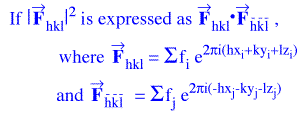Historically, the first class of structures that could be
successfully solved on a routine basis were heavy atom structures solved using
Patterson methods (in
crystallography, a “heavy atom” is one that has a lot of electrons). The electron density equation,

has, as the coefficients of a Fourier series, the structure factors, which are vector quantities. In
1935, A.L. Patterson replaced the structure factors (whose phases are unknown) with the square of the
structure factor, a scalar quantity:

This function, known as the Patterson function, can be calculated exactly using the intensity data
from the diffraction experiment. The utility of the Patterson function is apparent if the nature of
this new Fourier coefficient, the structure factor squared, is analyzed:

Thus, the coefficients of the Fourier series in the Patterson function are of the form:








